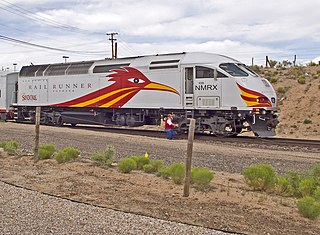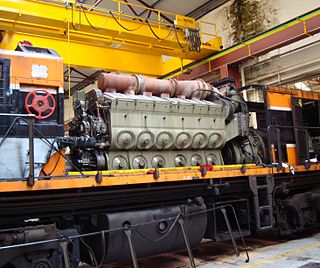
A switcher locomotive, shunter locomotive, or shifter locomotive is a locomotive used for maneuvering railway vehicles over short distances. Switchers do not usually move trains over long distances. Instead, they typically assemble trains in order for another locomotive to take over. Switchers often operate in a railyard or make short transfer runs. They may serve as the primary motive power on short branch lines or switching and terminal railroads.

A diesel locomotive is a type of railway locomotive in which the power source is a diesel engine. Several types of diesel locomotives have been developed, differing mainly in the means by which mechanical power is conveyed to the driving wheels. The most common are diesel–electric locomotives and diesel–hydraulic.

The EMD F40PH is a four-axle 3,000–3,200 hp (2.2–2.4 MW) B-B diesel-electric locomotive built by General Motors Electro-Motive Division in several variants from 1975 to 1992. Intended for use on Amtrak's short-haul passenger routes, it became the backbone of Amtrak's diesel fleet after the failure of the EMD SDP40F. The F40PH also found widespread use on commuter railroads in the United States and with VIA Rail in Canada. Additional F40PH variants were manufactured by Morrison-Knudsen and MotivePower between 1988 and 1998, mostly rebuilt from older locomotives.

The EMD SD90MAC is a model of 6,000 hp (4,470 kW) C-C diesel-electric locomotive produced by General Motors Electro-Motive Division (EMD). It is, with the SD80MAC, one of the largest single-engined locomotives produced by EMD and among the most powerful diesel-electric locomotives, surpassed only by the dual-engined DDA40X.

In rail transport, head-end power (HEP), also known as electric train supply (ETS), is the electrical power distribution system on a passenger train. The power source, usually a locomotive at the front or 'head' of a train, provides the electricity used for heating, lighting, electrical and other 'hotel' needs. The maritime equivalent is hotel electric power. A successful attempt by the London, Brighton and South Coast Railway in October 1881 to light the passenger cars on the London to Brighton route heralded the beginning of using electricity to light trains in the world.
Railpower Technologies is a subsidiary of R.J. Corman Railroad Group that builds environmentally friendly hybrid Green Goat and Genset switching locomotives, founded by Frank Donnelly and Gerard Koldyk. Its locomotives have been purchased by Canadian Pacific Railway, BNSF Railway, Kansas City Southern Railway and Union Pacific Railroad among others.

The passenger locomotives derivatives of the General Motors EMD GP40 diesel-electric locomotive have been, and continue to be, used by multiple passenger railroads in North America. For passenger service, the locomotives required extra components for providing steam or head-end power (HEP) for heating, lighting and electricity in passenger cars. Most of these passenger locomotives were rebuilt from older freight locomotives, while some were built as brand new models.

The MPI MPXpress is a line of diesel-electric locomotives built by MotivePower for commuter rail service. There are five MPXpress models: MP36PH-3S, MP36PH-3C, MP40PH-3C, MP32PH-Q, and MP54AC.

The ALCO FA is a family of B-B diesel locomotives designed to haul freight trains. The locomotives were built by a partnership of ALCO and General Electric in Schenectady, New York, between January 1946 and May 1959. Designed by General Electric's Ray Patten, they were of a cab unit design; both cab-equipped lead FA and cabless booster FB models were built. A dual passenger-freight version, the FPA/FPB, was also offered. It was equipped with a steam generator for heating passenger cars.
National Railway Equipment Company is an American railroad equipment rebuilding, leasing, and manufacturing company, headquartered in Mt. Vernon, Illinois. NREC sells new and rebuilt locomotives to railroad companies worldwide, with an emphasis on the North American market.

In engineering, a prime mover is an engine that converts chemical energy of a fuel into useful work. In a locomotive, the prime mover is thus the source of power for its propulsion. In an engine-generator set, the engine is the prime mover, as distinct from the generator.

The NRE 3GS21B is a low-emissions diesel genset locomotive built by National Railway Equipment (NRE). Instead of a single prime mover, the NRE genset locomotive is powered by three separate 700 horsepower (522 kW) Cummins QSK19C engines providing a total power output of 2,100 horsepower (1,570 kW). Each engine could be individually started or shut off depending on how much power is needed, reducing overall diesel emissions and improving fuel efficiency. More than 150 of the 3GS21B genset locomotives have been produced to date, with the majority of these units being manufactured at NRE's Mount Vernon shops in Southern Illinois. In addition, three road slug models have also been produced. The main difference between this and the NRE 3GS21C is that these units are on B-B trucks and the others are on C-C trucks.
The NRE 1GS7B is a low-emissions diesel switcher locomotive built by National Railway Equipment. It is powered by a single Cummins QSK19C I6 engine which develops a total power output of 700 horsepower (522 kW). There have been nine 1GS7B locomotives produced to date, manufactured at NREC's Mount Vernon shops in Southern Illinois, and at NREC's Dixmoor shops. It's also the only current single-engine switcher marketed in NRE's N-ViroMotive catalog.

The Railpower GG20BGreen Goat is a low-emissions diesel hybrid switcher locomotive built by Railpower Technologies Corp. It is powered by a single Caterpillar C9 six cylinder inline engine developing 300 horsepower (224 kW), which is also connected to a large battery bank where both sources combine for a total power output of 2,000 horsepower (1,490 kW). To date, there have been more than 50 GG20B diesel-electric hybrid switchers manufactured since their first introduction in 2004.
The EMD SD22ECO is a 2,150 hp (1,600 kW) C-C diesel-electric locomotive rebuilt by Electro-Motive Diesel. It is, along with the GP22ECO, primarily the application of a conversion kit to an existing EMD SD40-type locomotive. This involves replacing the existing prime mover with an EPA Tier-II-compliant turbocharged V8 710G3A-T2, with electronic fuel injection. The prime mover is mated to an AR10 alternator for traction power, a CA6 alternator for control power, and a computerized control system. This conversion does not alter the external appearance of the locomotive.
The NRE 3GS21C is a low-emissions diesel genset locomotive built by National Railway Equipment (NRE). It is powered by three Cummins QSK19C I6 engines with each one developing 700 horsepower (522 kW) and creating a total power output of 2,100 horsepower (1,570 kW). Instead of a single prime mover, the NRE genset locomotive has three engines that each can be turned off or on as power is needed reducing overall diesel emissions and improving fuel efficiency. At least 27 3GS21C genset locomotives have been produced to date at NRE's Mount Vernon shops in Southern Illinois. The main difference between this and the NRE 3GS21B is that these units are on C-C trucks and the others are on B-B trucks.

The Great Northern Railway (GNR) Class L1 was a 0-8-2T side tank steam locomotive designed by Henry Ivatt. It was originally designed for suburban passenger traffic on the Metropolitan City Lines.
The NRE 2GS36C-DE is a low-emissions six-axle diesel-electric road switcher locomotive built by National Railway Equipment Company. It is part of NRE's N-ViroMotive line. It is powered by two Cummins QSK50L V16 engines rated at 1,800 horsepower (1,340 kW) each, for a total power output of 3,600 horsepower (2,680 kW). It has a starting tractive force of 126,000 pounds-force (560,000 N), an adhesion rate of 30%, and a minimum continuous speed of 13.9 miles per hour (22.4 km/h). It offers Tier III emissions compliance.
The WDM-2G is a class of diesel electric genset locomotive used in Indian Railways. It is one of the rarest locomotives in India with only two units being produced by Patiala Locomotive Works (PLW). The locomotives were produced with an intention of being fuel efficient and to be used for light to medium duties such as short passenger runs along with occasional shunting. They are one of the only two classes of locomotives in India to feature multiple prime movers, the other example being WDS-6G, which was designed solely for shunting. They have a rated power of 2,400 HP.

The NRE 2GS12B is a low-emissions diesel genset switcher locomotive built by National Railway Equipment Company as part of its N-ViroMotive series of low-emission locomotives. It is powered by two Cummins QSK15, a straight-six engine, with each one developing 600 horsepower (450 kW) and creating a total power output of 1,200 hp (890 kW). The locomotives are compliant with the EPA's Tier 4 emissions standards requirements for non-road diesel engines.












